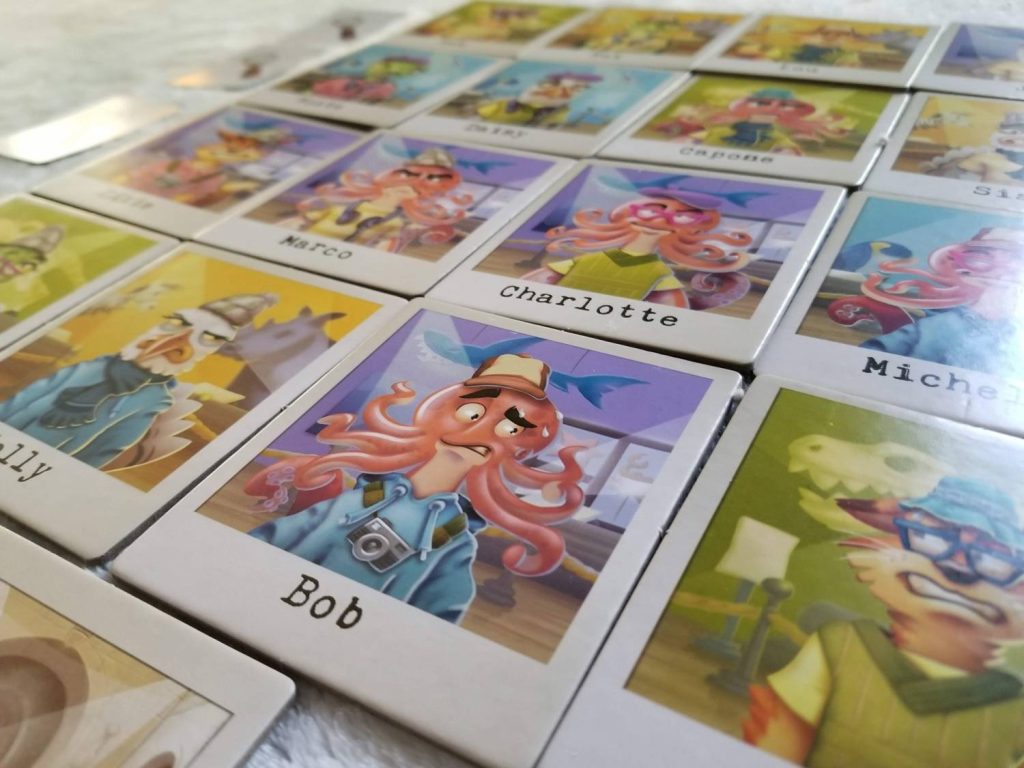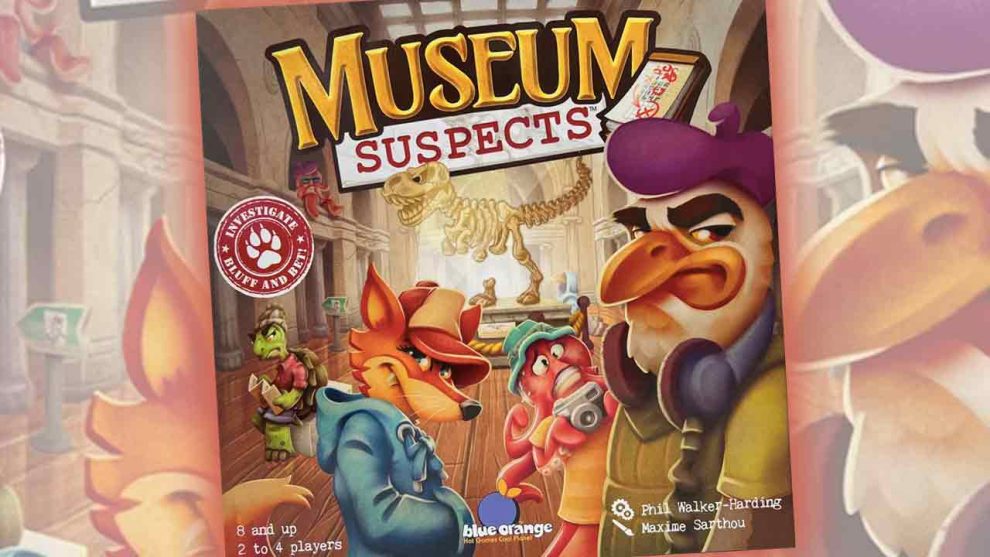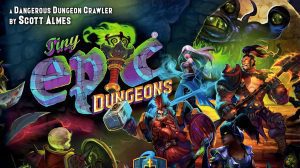Disclosure: Meeple Mountain received a free copy of this product in exchange for an honest, unbiased review. This review is not intended to be an endorsement.
Sound the alarms! Bolt the door! There’s been a robbery at the museum. You and the other players are master detectives that have been recruited to suss out the identities of the culprits, assuming they’re still in the building.
Each player is provided with a collection of numbered tokens that they will spend to peek at hidden clues and to suggest suspects. Each clue reveals some aspect that does not match up with the culprit. As clues are revealed to the players, they will mark them off in their handy, dandy, notebooks. After gathering a new clue, the players will then propose suspects by selecting one of their numbered tokens and placing it face down onto one of the museum patrons that are arranged in the center of the table. Each player will have six opportunities to look at clues and six chances to guess the correct suspect(s). Once everyone’s place their sixth guess, the clues are revealed and the suspects are eliminated one by one until only the culprit(s) is/are left…unless they’ve already escaped. The player that guessed correctly with the highest valued tokens wins the day.
Of course, this is a high-level overview of the game. If you’ve already heard enough and just want to see what I think about the game, feel free to skip ahead to the Thoughts section. Otherwise, read on as we learn how to play Museum Suspects.
Setup
The Suspect tiles are shuffled together. The sixteen are selected at random and placed into a 4×4 grid. The Clue cards are arranged by type (there are eight types). Each of these decks is shuffled and one card is drawn at random. These drawn cards are placed together to form a new deck, which is shuffled, before dispersing the cards, face-dnw, at the two ends of each of the four rows of Suspect tiles. The Exit tile is placed at the bottom of this grid.

Next, each player is given a Notebook, a pencil, and all the Investigation tokens of their chosen color. Now you’re ready to play Museum Suspects. The person that was given the Player A token starts the game.
A Round of Play
On a player’s turn, they will choose one of the face-down clues at which to peek. After peeking, they must place one of their numbered Investigation tokens face-up onto the card. The token placed must be of equal or higher value than any previous tokens that have been placed onto the clue. The clue they have seen is marked off in their Notebook along with any of the suspects that exhibit the clue. For instance, if the revealed clue shows the aquarium background, any suspects that feature that background can be eliminated.

Next, the player must suggest a suspect. They will choose one of their Investigation tokens and then place it face-down onto any of the sixteen Suspect tiles of their choice. If they suspect that the culprit has already left the building (or if they just feel like it), then they’ll place their face-down token on the Exit tile instead.
End of the Game
After every player has placed their six face-down Investigation tiles, the game comes to an end. Each Clue card is revealed, one at a time, and any eliminated Suspect tiles are flipped to their opposite sides. Once all Clue cards have been revealed and suspects eliminated, any that remain face up are the culprits. If none remain face up, then the culprit escaped.
Any players that have tokens on the culprits (or the Exit tile) reveal the values on their tokens. If only one culprit (or just the Exit tile) remains, the player with the highest total value assigned to the tile wins. If multiple culprits exist, each player earns points equal to the value printed on the tokens as well as an extra point for each suspect they got correct. The player with the highest total value wins. There is no tie breaker.
Thoughts
Have you ever encountered a game that you thought you’d like, wind up not enjoying it, and then, because you’re a fan of the designer, you walk away feeling ashamed that you didn’t enjoy the experience? That’s how Museum Suspects makes me feel. I don’t know what it is about this game, but it just doesn’t do it for me. It’s a shame, too. Here at Meeple Mountain, we love ourselves some Phil Walker-Harding (PWH). With splendid titles like Gizmos, Sushi Go!, and Imhotep on his resume, it’s hard not to. So, when the offer to review one of his latest creations went out, I was quick to leap onto the opportunity.
When the game arrived, I eagerly ripped off the shrinkwrap and dug right in. I was immediately taken in by how good it looks. Maxime Sarthou has done an excellent job of bring PWH’s vision to life. The colors are bold and vibrant. The characters are well drawn. Each of the museum visitors exudes a unique personality, a tough feat to pull off since there are specific elements that need to be in each image (their hats, defining facial characteristics, etc.) in order for the game to work.

Unfortunately, that’s pretty much where the good stuff ends. The problems with Museum Suspects become apparent right away. For starters, consider the concept: the players are master detectives trying to uncover the identities of the thieves. There’s nothing wrong with that in and of itself. But when you factor in that each turn requires you to look at a clue and then suggest a suspect, the thematic issues rise to the surface like unincorporated powdered creamer in a cup of gas station coffee.
To paraphrase our editor, Andy Matthews, during his first play of the game with me: “that’s some really shoddy police work”.
With only a single clue gathered, you’re already pointing fingers. And it’s not even a clue about who the culprit is. It’s a clue about who the culprit isn’t. Unless every suspect but one exhibits whatever aspect you’ve identified that the culprit doesn’t, this clue is absolutely useless and it’s definitely not enough to accuse someone of a crime.
I can overlook thematic issues, though, as long as the game itself is okay. But Museum Suspects just isn’t. For instance, in my very first game, my wife and I ran into a pretty egregious issue during end-of-game scoring. As I mentioned earlier, each clue card that you peek at indicates some clue that does not apply to the culprit. If the clue card features a blue bucket hat (very specifically shown on row two in the Notebook), then the culprit is not wearing a blue bucket hat. If the card features a pink shirt (very specifically shown on row four), then the culprit is not wearing a pink shirt. If the culprit is wearing blue horn-rimmed glasses (very specifically shown on row three), then the culprit is not wearing blue horn-rimmed glasses.
But wait. There’s a suspect that’s wearing blue circular glasses. In our game, I eliminated this suspect but my wife did not. I read the clue as “blue glasses” but she read the clue as “blue horn-rimmed glasses specifically”. If my take on it was correct, then I would win. If hers was, she would win. So I put it to the rules forum on BGG and it was confirmed that my take on the clue was the correct one. I’d won, but it didn’t feel that way. Why are rows two and four ultra-specific while row three is so generic? That poor artistic choice/poor rule book wording/poor design decision (take your pick) led to a lot of confusion and discord. Any feelings of goodwill that we’d felt for the game vanished in an instant. The entire experience just left me feeling hollow and unaccomplished.
And that’s another thing about Museum Suspects that I take issue with. After all is said and done, after all the dust is settled and a victor has been declared, you haven’t really accomplished anything. If you happen to peek at the right clues, you win. If you didn’t peek at a clue that held some critical information, you lose. Whether you win or lose just comes down to pure, dumb luck.
Aside from everything else I’ve groused about, I think the biggest issue with this game is that it struggles with its own identity. While it feels like Museum Suspects is trying to straddle the line between a deduction game and a bluffing game, it just manages to trip over that line repeatedly before falling on its face. As mentioned before, you’re never given enough information to reasonably deduce anything. So the game fails as a deduction game. And, since all of your Investigation tokens are visible for the entirety of the game, the bluffing mechanism never works as you might think it would either.
Consider this: laying before me are four tokens numbered one through four. I use the number two token to peek at a clue. Then I place a token face down onto one of the suspects laid out before us. I am left with the number one and the number three. Guess which token I placed face down? It’s pretty easy to figure out I placed the four, isn’t it? So, with open information, why require me to place my tokens face down in the first place? And, assuming that restriction is removed, why would I waste my high value number four on a suspect that I know is not the culprit? To try and convince you that I know something you don’t? That’s an expensive bluff. And if I placed a number one instead of a four, then you could reasonably assume that I’m unsure about the suspect that I did choose. Since you can place any value you want on a suspect, then you could easily place a value one yourself onto the same suspect later on and neither one of us would have gained a leg up on eachother if that suspect really does turn out to be the culprit.
It just doesn’t make sense to have to place tokens face down when everyone can see which tokens you have peeked at clues with already and which tokens you have left at any given time. It seems like this could easily have been resolved by including player screens to hide your tokens behind. But they weren’t and it’s anyone’s guess why.
I really wanted to like this game, but I just don’t. It’s rare that I encounter a game that I have no desire to ever play again, but this is one of them. It’s not because Museum Suspects leaves a bad taste in my mouth. Bad tastes, as foul as they are, are at least memorable. But Museum Suspects is just a bland, unseasoned mess.












Add Comment